Day 6: Lower Manhattan Walking Tour
This morning we were met by Ed O’Donnell, a personable guide with extensive knowledge of the New York area. I want to take a moment to offer kudos to Ed, who not only imparted a lot of information, but also shepherded this large group through the subways and across busy streets to multiple venues across lower Manhattan.
The first stop we made at the African Burial Site is central to my teaching, and I plan on incorporating it in my lessons relating to slavery this year. I have always known and taught that slavery existed in the North (New York City included) as well as the South and refuting the myth that it was a southern institution. I was unaware that New York City was the leading slave city in America as late as the 1750s and that it also had the highest ratio of blacks to whites in colonial America. I hope to use this site to illustrate more tangibly the pervasive nature of slavery in the north. I thought that the memorial was powerful in its message. As for the overall trip to New York I thought that this was highly instructive in showing the presence of this burial site amid the high rises of lower Manhattan illustrating again how this city has changed time and again from its roots. The actual monument is a small portion of the actual burial site, virtually guaranteeing that time and construction, destruction, and reconstruction have literally steamrolled most of the gravesites in this plot. One wonders how many countless other gravesites in New York have been similarly affected by changing times.
Traveling further south, we saw the first department store in America, the Marble Palace, completed in 1846. Shortly down the way we saw the gothic features of the 55-story Woolworth building completed in 1913 as a testament to this multi-featured shopping extravaganza’s success.
Another feature that we saw was the New York County Courthouse, which witnessed the rise and fall of William Marcy (Boss) Tweed. It was originally slated to cost a quarter of a million dollars, but instead cost the taxpayers more than thirteen million dollars due to the corruption and illegal kickbacks of the Tweed Ring. Having taught the Gilded Age for years and having read The Great Bridge, it was nice to see where it all happened.
Ed showed us the commons area near City Hall which was at one time a smoldering hotbed of colonial resistance to the British Crown. He noted that an event similar to the Boston Massacre took place in New York in January 1770, two months before the incident in Boston, the only difference being that nobody was killed. Near the end of our tour in the afternoon, he also took us to Bowling Green, where exultant Patriots tore down the statue of King George III after the Declaration of Independence was read.
At Trinity Church we saw the final resting place of Alexander Hamilton, one of the most brilliant of the “founding fathers.”
One of the things that I liked about Ed’s presentation is that it gave me a better sense of the geography of lower Manhattan, whether it was his cogent explanations of where the waterfront used to be (prior to excavations and landfills), where the canals were, or most helpful, the topography around Broadway where he pointed out that it was once a ridge that ran down to the tip of Manhattan with slopes on either side.
We rounded up our tour seeing Fraunces Tavern, where Washington bade farewell to New York at the end of the American Revolution, and then with a trip to Wall Street where we saw the New York Stock Exchange and Federal Hall, the site where George Washington was sworn in as President of the United States (although the building itself no longer exists). This was another instructive piece on how New York re-makes itself, as Ed stated that New York saved fewer historic places than any other colonial city, attributing this to the fact that New Yorkers have always been a forward-looking people. I thought that this was a salient comment given what we have seen here in the last week.
With respect to one building that has seen it all (or most of it), we visited St. Paul’s Church, built in 1766 and across the street from the World Trade Center site. St.Paul’s has been charmed, having escaped the fires that ravaged New York during the American Revolution and burned down everything around it. Then, on September 11, 2001, its grounds were littered with debris and dust, but the church itself was untouched and in fact became an aid station for the heroic rescue and recovery teams that combed Ground Zero. Memorials to the fallen and tributes to the emergency workers line the inside of the church, and bring back vivid memories.
Across the street, life goes on and New York re-makes itself just as it has for four hundred years. Cranes lift steel beams into place as a new tower and companion buildings rise above street level. Soon, the a new World Trade Center will take the place of an empty void, and reflecting pools will whisper the memories of a tragedy in the past, and New York will push forward just as she always has.
After the close of business, Patts and I paid a visit to Carnegie Deli on 55th Street and 7th Avenue. The walls were covered with the famous clientele who had passed through their doors. We split a “Woody Allen,” a pastrami and corned beef on rye. Make sure you go there hungry!
We later visited several landmarks and walked back to the hotel across the Brooklyn Bridge.
As we neared our hotel, we saw what appeared to be a bum laying on the ground by his cart working on a laptop…
Explore posts in the same categories: Uncategorized


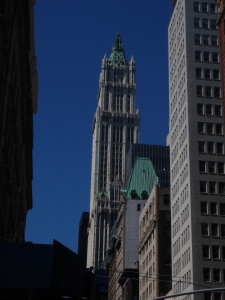







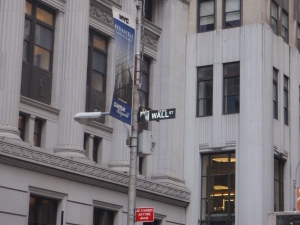





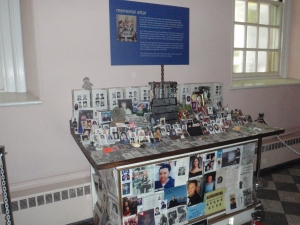

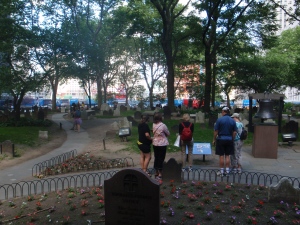






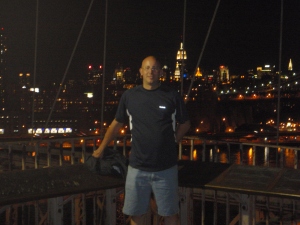


June 10, 2010 at 12:07 am
Thank you for the great pics. I especially appreciate the the African Burial ones and the beautiful sentiment in the inscription.
The WTC always makes me sad. I wish they had just rebuilt the towers to show that the Americans won afterall.